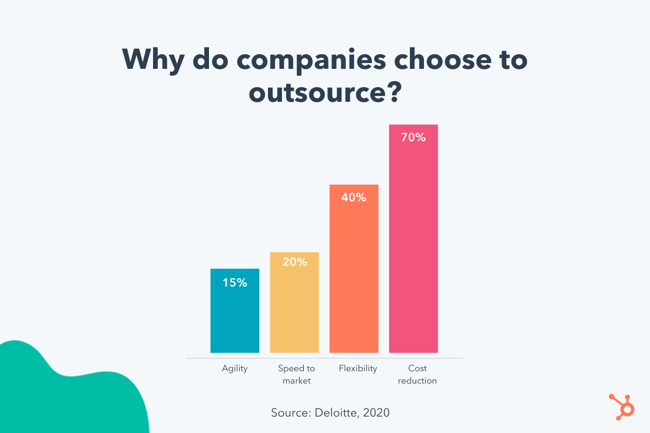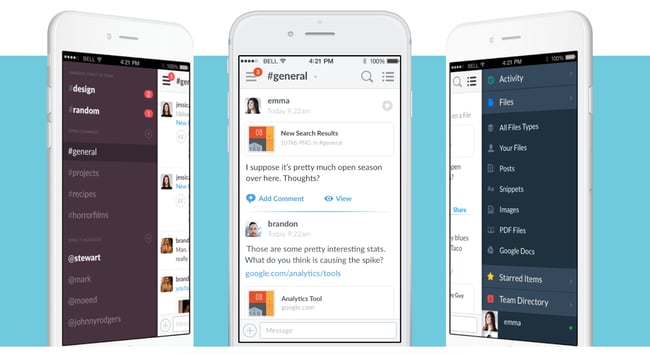You know the feeling of bliss you get when you reach inbox zero or cross the last item off your to-do list? Yeah, neither do most of us. Because of that, many companies turn to outsourcing as a tool for small or overworked teams.

It doesn't end there — other companies rely on outsourcing to fill knowledge or skill gaps they don’t yet have the headcount or budget to hire for internally, including paid advertising, video production, and payroll.
Think you might need to outsource some projects? Here, we'll look at the pros and cons of outsourcing, see it in action with a few examples, and explore which tasks businesses commonly outsource.
What is Outsourcing?
Outsourcing is the practice of hiring outside specialists or generalists to perform certain tasks that are traditionally done in-house. Often, this involves delegating time-consuming or tedious tasks across multiple departments — from HR and accounting to administrative and customer service.
Ultimately, the goal is to free up time for your team to focus on more revenue-generating tasks.

According to a recent Deloitte study, the primary reason why companies outsource is to reduce operating costs. In the context of a pandemic, this makes sense — for many, such economic uncertainty has switched the focus back to the numbers. Further, it's much easier to measure cost than to articulate the benefits of, say, agility or flexibility.
Companies also choose to outsource work to elevate the way they do business, be more flexible, and improve their overall speed to market.
Let's look at how two companies, Slack and WhatsApp, use outsourcing to meet business goals.
Example 1: Slack

Slack, a workplace communication tool, has become one of the most popular corporate chat rooms. It's hard to believe that it owes much of its success to outsourcing.
Back when Slack was just a rough prototype, the company hired a Canadian design team, MetaLab, to design the app from the ground up — along with the brand and website.
Leveraging MetaLab's expertise in interface design, the Slack team overhauled its model with playful colors and interactive elements.
Since officially launching in 2013, Slack has become the fastest growing business application of all time. It's also a prime example of why outsourcing is such a powerful tool to grow and scale a business. It also speaks to how outsourcing can play a role in even the most crucial parts of a company — such as its entire look and feel.
Example 2: WhatsApp

WhatsApp is a messaging app used by millions around the globe to send texts, images, and audio. In 2012, the scrappy startup had only 30 full-time employees and a handful of part-timers at its California headquarters.
To scale the company while reducing costs, it chose to outsource most of its development to a group of app developers in Russia. In doing so, its California team could focus on other operational and customer support functions.
By outsourcing, WhatsApp was able to unlock access to global talent at a significantly lower cost while alleviating the workload for its California team.
Pros and Cons of Outsourcing
- Pro: Cheaper than full-time staff
- Pro: Faster turnaround
- Pro: Specialization
- Pro: Access to more talent
- Pro: Can prevent burnout of full-time staff
- Con: They don't know your business
- Con: Communication challenges
- Con: Difficulty with quality control
- Con: Can be tough on team morale
- Con: Slow response time
1. Pro: Cheaper than full-time staff
Outsourcing certain tasks, like content writing or accounting, can be cheaper than hiring a full-time employee. You'll save on onboarding costs, healthcare coverage, and compensation.
2. Pro: Faster turnaround
Depending on the task, the person you outsource may only take one project at a time. Having one person devoted to your job allows it to get done faster. Setting a timeline up front makes it easy to dictate when you need a job finished. Since a freelancer won't have the other demands of a full-time position to contend with, you can set aggressive (but realistic) timelines.
3. Pro: Specialization
Need to hire a designer who specializes in stop-motion graphics? Outsourcing makes it easy to hire an agency or freelancer who's an expert at stop-motion instead of an all-purpose, full-time designer who might not have stop-motion experience but will be a more realistic choice for day-to-day needs.
4. Pro: Access to more talent
Outsourcing allows you to hire the best of the best in your area of need. You're not vetting and hiring a full-time employee who meets a long list of requirements. Instead, you can narrow down your search to those who specialize in a particular area. For example: recruiters with experience helping startups develop a diverse baseline team.
5. Pro: Can prevent burnout in full-time staff
Outsourcing can save the day if you don't have the budget to hire a full-time position but need to provide a little relief to your existing team. By taking simple tasks or time-consuming projects off their plates, you can keep your salaried employees happy and avoid costly burnout and turnover.
6. Con: They don't know your business
While a good freelancer will do their best to learn your company's goals, brand, and style, it's not realistic to expect them to understand your business like a full-time employee does.
7. Con: Communication challenges
You might hire a freelancer without ever actually meeting in person. It's not unusual to conduct business with them entirely online or over phone or video communication. While today's digital workplace makes this increasingly easy, communication difficulties inevitably arise from working in different time zones, playing phone tag, or trouble communicating over email.
8. Con: Difficulty with quality control
Make sure you're checking on their progress throughout your contract period. There's nothing more devastating to both parties than getting a finished product and finding that your freelancer has missed the mark.
9. Con: Can be tough on team morale
If you outsource warm outreach to another sales organization, your sales team may feel nervous you're moving toward a fully outsourced sales program. If you outsource, make sure you clearly communicate the reasoning and goals behind outsourcing. For example, "We're outsourcing initial outreach to give our existing sales team more time to close higher-value deals."
10. Con: Slow response time
Remember, you might not be the only client a freelancer has. Unlike an employee, you can't tell a contractor to prioritize a certain project. Be respectful of their time, but assertive if they're not meeting the milestones of your agreed-upon timeline.
How to Tell if You Should Outsource a Task
When you’re part of a small team or growing business, it’s tough to allocate budget for other people to complete tasks that normally fall to you or your internal team. Instead of thinking about the extra money you’ll spend, think of it as an investment in the growth and productivity of your team.
And before outsourcing a task or project, have a checklist of questions you ask yourself:
- Is the task a primary service or benefit of your business offering? If yes, consider hiring someone internally to scale company growth responsibly. If not, it might be a task worth outsourcing.
- Will outsourcing this task free up time for you to grow your core business or product? If that’s a yes, outsource it.
- Will it cost less to outsource this task than to hire someone new or tackle the task internally? If yes, outsource it.
- Can someone else complete this task better and faster than your internal team? If yes, you should outsource.
- Is this a rare or one-time need? If so, it’s time to outsource.
- Will it give you a competitive advantage to handle this task in-house? If so, try to hire staff or complete this project internally to avoid outsourcing.
It’s important to know when it’s time to outsource and when to buckle down and develop self discipline to finish tasks internally.
By using this list of questions as your compass for whether or not to outsource a task, you’ll ensure your decision to outsource is always the right one. These questions will keep you honest and your business growing steadily. This list of best sales tools for small businesses can help too
Outsourcing Examples
Content writing, human resources, and accounting are commonly outsourced tasks. It's often less expensive for small businesses to outsource these tasks than to hire full-time help.
Outsourcing Marketing and Design
Small businesses often don't need the volume of content and design work that necessitates a salaried position. By employing freelance writers and designers, businesses can pay by the blog post or creative project instead.
- Social media content creation
- Social media management
- Logo design
- WordPress design
- Newsletter creation
- Voiceover talent
- Webinar management
- Email management
- Data management and reporting
- E-book creation
- Proofreading
- Canva image creation
- PPC campaign management
- Writing and blogging
- Research
- Competitive and industry research
- Web maintenance
- Graphic design
- Presentation preparation
- Conference submissions
- Guest blog outreach
- Blog comment moderation
- Video production
- Email design
- Podcasting
- Photoshop
- Video editing
- Press release writing
- Public relations
- SEO optimization
- SEO site audit
- Link building
- App development
- Influencer marketing
- Photography
- Photo editing
- Editorial calendar management
- Infographic creation
- Market research
- Branding
Outsourcing Administrative Tasks
If you're bootstrapping a business and need your or your team's time to be devoted to high-value projects, outsource administrative tasks. Having someone manage your calendar, plow through mindless data entry, or transcribe meeting minutes can give you extra minutes back in your day.
- Calendar scheduling
- Meeting minutes
- Travel
- Greeting card sending
- File management
- Transcription
- Reminder services
- Data entry
- Client invoicing
- Voicemail checking
Outsourcing Sales and Support
Similarly, there's a lot of administrative work in sales and support. If you need your reps purely devoted to outreach and demos — and not to data entry — it might be time to outsource.
- Lead generation
- Customer service
- Expense report creation
- CRM updating
- Prospecting
- Pre-meeting research
Outsourcing HR and Operations
Don't have the time or expertise to take care of your company's taxes or hiring? These are just a few of the jobs you can outsource. This cuts down on costly errors and draws on the expertise of others.
- Training
- Taxes
- Payroll
- Recruitment
- Job posting
- Candidate follow-up
- Candidate screening tests
- Background checks
- Contract management
- Onboarding
- Project management
- Order fulfillment
- Inventory management
- IT support
Outsourcing Personal Tasks
Sometimes everything is going well at work but your personal life is suffering because of it. In this case, hire help with tasks like laundry, house cleaning, or grocery shopping to give you better work/life balance.
- Personal errands
- School pickup and drop off
- Meal preparation
- Grocery shopping
- Doctor appointment scheduling
- Mail pickup and drop off
Outsourcing is a form of business delegation that can save you time, money, and energy better spent on growing your team or business. Consider outsourcing where it makes most sense for your company and foster a healthier work environment and better results.
Entrepreneurship

.jpg)
![7 Ways to Recession-Proof Your Business [+9 Recession-Proof Business Ideas]](https://2406023.fs1.hubspotusercontent-na1.net/hubfs/2406023/Imported_Blog_Media/Recession%20Proof%20(1).jpg)
![Target Markets: Why They Aren't Just for Marketers [A Quick Guide]](https://2406023.fs1.hubspotusercontent-na1.net/hubfs/2406023/Imported_Blog_Media/Target%20Market.jpg)
.jpg)
